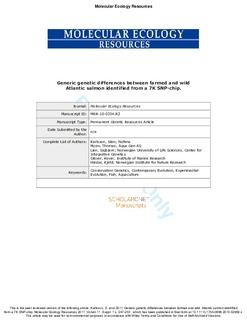Generic genetic differences between farmed and wild Atlantic Salmon identified from a 7K SNP-chip
Peer reviewed, Journal article

Åpne
Permanent lenke
http://hdl.handle.net/11250/2593228Utgivelsesdato
2011Metadata
Vis full innførselSamlinger
- Scientific publications [1392]
Originalversjon
10.1111/j.1755-0998.2010.02959.xSammendrag
Genetic interactions between farmed and wild conspecifics are of special concern in fisheries where large numbers of domesticated individuals are released into the wild. In the Atlantic salmon (Salmo salar), selective breeding since the 1970’s has resulted in rapid genetic changes in commercially important traits, such as a doubling of the growth rate. Each year, farmed salmon escape from net pens, enter rivers, and interbreed with wild salmon. Field experiments demonstrate that genetic introgressi on may weaken the viability of recipient populations. However, due to the lack of diagnostic Genetic markers, little is known about actual rates of gene flow from farmed to wild populations. Here we present a panel of 60 single nucleotide polymorphisms (SNPs) that collectively are diagnostic in identifying individual salmon as being farmed or wild, regardless of their populations of origin. These were sourced from a pool of 7000 SNPs comparing historical wild and farmed salmon populations, and were distributed on all but two of the 29 chromosomes. We suggest that the generic differences between farmed and wild salmon at these SNPs have arisen due to domestication. The identified panel of SNPs will permit quantification of gene flow from farmed to wild salmon populations, elucidating one of the most controversial
potential impacts of aquaculture. With increasing global interest in aquaculture and increasing pressure on wild populations, results from our study have implications for a wide range of species.